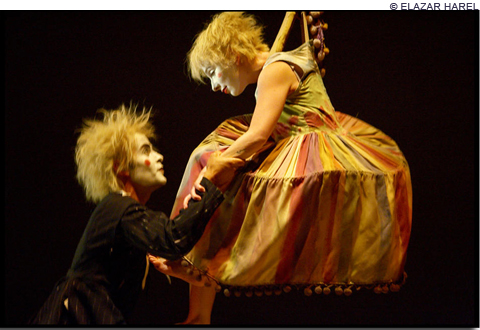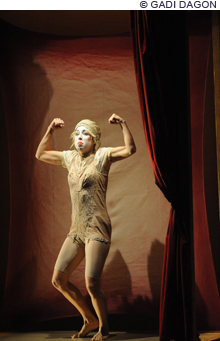
SIDE SHOWS Oyster's various tableaux had the effect of scenes along a circus midway. |
All the characters in Oyster, the Israeli show presented by Celebrity Series last weekend at the Paramount, are physically challenged in some way. Their heads or their arms are missing, they've acquired surplus limbs, they lose the power to move and have to be hoisted around by others. They imitate the spectacular stunts that circus performers command, but they never quite achieve the thrill. Their charm lies in their failure to impress.Co-directors Inbal Pinto and Avshalom Pollak seem to have been influenced by the European whiteface mime tradition practiced by Marcel Marceau. Everything is reduced in scale and the action is indicated rather than projected full-out. You can easily miss the climax or the joke. The hourlong series of sketches takes place within several smaller spaces, defined, inside the theater's proscenium, by two strings of lights, and within those, an inner proscenium that frames an even smaller wagon-stage pushed in and out by the actors. We could be strolling along a circus midway and peeping into the stalls.
In addition to their clown makeup, the performers all wear frizzy wigs, mostly white, and shabby costumes that might once have been gaudily decorated. Some of them clutch tiny umbrellas or other comforting objects. They're all of indeterminate gender and identifiable only by their costumes, so they don't read as individuals. They usually arrive with one or more companions who do the same thing. Two types in pink tutus appear first on a leash, like performing dogs. Whenever they return, even without their owner, they do their tricks in tandem. There's a group in droopy black tuxedo-like suits, and another group in flesh-colored wornout underclothes. The whole cast is never onstage at once, so there seem to be more of them than the 12 who take the final bow.
 |
Besides the tutu-dogs, the cast of characters includes a person in a tutu that has a tiny stool conveniently attached to its rear. There's a small, stout figure who could be a grandmother, whether she is the good or the evil kind is not determined. A tall object on wheels turns out to be an outsize overcoat that conceals two persons, stacked one atop the other. This totem pair take turns making each other move like puppets. In fact, many of the characters manipulate the moves of others.Dance numbers alternate with wispy, dramatic incidents, all hampered in some way. In one scene, the dancers are twirled around by the neck, in thrall to their tuxedo-clad keepers. A group does a dance with red tapes stretched between their hands and feet — they have to keep their arms and legs stuck out straight or the tapes will crumple. A tuxedo group dances a stomping, tumbling routine, all of them armless.
A small person in a tutu hangs on a rope by a harness; one tuxedo-person hauls the other end of the rope so she flies up and down, landing on the shoulders or the arm of another tuxedo-person. Only the rope-puller knows when she'll rise and when she'll drop. The two tutu-dogs play a love scene that grows anxious when tuxedo-personscarry cloud-shaped objects across the inner-stage. After the storm passes, the lovers reconcile.
 Topics
Topics:
Dance
, Dance, reviews, oyster